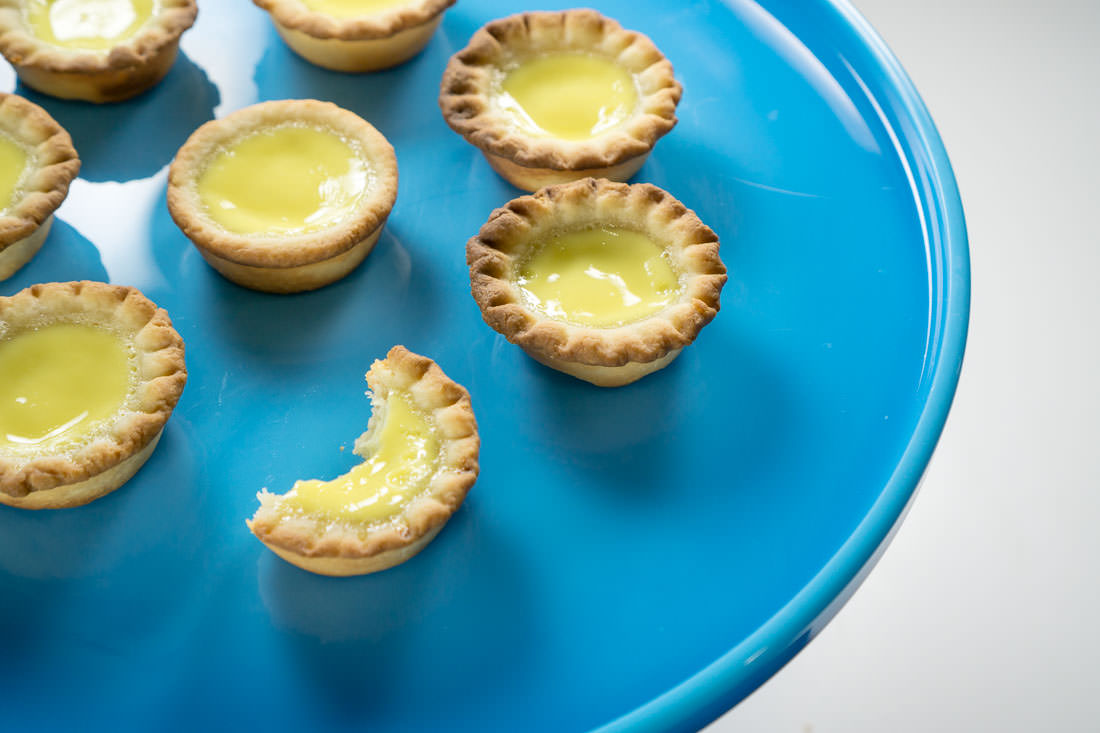
Hong Kong-Style Egg Tarts with Cream Cheese Crust
An egg tart recipe that reminds me of my childhood. The cream cheese in the tart crust adds an edge of delicious savoriness that cuts the bland sweetness of the custard.
Ingredients
For the tart shells:
- 4 oz. cream cheese softened
- 1 stick of butter softened (salted – or add 1/4 tsp. salt to the dough)
- 1 and 1/2 cups all purpose flour
- ½ cup confectioner’s sugar
- Cooking spray
- Pie weights I use raw beans or rice reserved for this purpose
- 1 egg white beaten lightly
For the custard:
- 2 eggs plus 1 egg yolk
- 1 and ¼ cups milk
- 6 Tbsp. granulated sugar
- ¼ tsp. vanilla extract
- Pinch of salt
Instructions
- Grease 24 mini-muffin tins. (You could also use 12 regular-sized muffin tins or your choice of tart tin; you’ll likely have to closely monitor the baking of the tart shells and adjust the baking time for the custard-baking portion of the recipe.)
- Mix the cream cheese and butter together in a medium bowl. With a sieve held over the bowl of butter mixture, sift in the flour and confectioner’s sugar. Mix just until a dough forms and you no longer see large pockets of unincorporated cream cheese or flour/sugar.
- Divide the shell dough into 24 pieces and press firmly into tins. (Set a little dough aside for patching any holes that emerge during the tart shell baking process.) If you’d like, you could also decoratively flute the tart shell edges with a chopstick. Prick the bottoms of the tins lightly with a fork to prevent the dough from puffing up.
- Freeze the tart shells in their pan for at least 15 minutes.
- Preheat the oven to 425 degrees Fahrenheit. Tear off 24 small pieces of foil to fit inside the tart shells and lay them out on a cookie sheet in one layer, shiny-side-up. Spray the foil with cooking spray.
- Remove the tart shells from the freezer. Tightly press a piece of the foil inside each tart shell, oiled-side-down, taking care to avoid any decorative fluted edges. Fill each foil-covered frozen tart shell with beans or rice.
- Bake the tart shells for 1 minute, and then lower the temperature to 290 degrees. Bake about 9 more minutes until the tart shells are lightly browned around the edges, monitoring them closely throughout. If they are browning too quickly, lower the temperature further by opening the oven door.
- Remove the tart shells from the oven and let cool for at least 3 minutes. Slowly and carefully ease the foil cups out of each tart shell. You will probably see that the edges of the tart shells are no longer raw, but the bottoms of the tart shells will still be a little raw. If the bottoms of the tart shells have puffed up, press them down, and return the tart shells to the oven. If large cracks or holes have developed in the bottoms or sides of the tart shells, patch them with a tiny piece of leftover dough that you reserved from earlier.
- Bake tart shells for another 5 minutes until dry. (Again, closely monitor the tart shells -- if the edges are browning too quickly, lower the temperature or crack open the oven door for a few seconds to manually lower the temperature.)
- Remove tart shells from oven. With a pastry brush (or, in an pinch, a paper towel), brush the inner surface of the tart shells with the egg white to seal any small holes. (You don't want the custard to leak out of the holes!) If larger cracks have formed during the baking process, take a tiny pinch of the leftover dough and patch up the cracks. Return the tart shells to the oven for 2 more minutes. Remove tart shells from the oven and set aside to cool for at least 10 minutes while you make the custard filling.
- Raise the oven temperature to 325 degrees Fahrenheit.
- While the shells are cooling, heat the milk and sugar in a small saucepan over low-medium heat, stirring frequently to prevent milk from scorching, until sugar is dissolved but milk is not yet boiling. Remove from heat and set aside.
- In a small bowl, beat the eggs and egg yolk, then slowly drizzle in about half of the warm milk mixture, whisking the mixture constantly with your other hand. Once the eggs have been incorporated with about half of the milk mixture, add the rest of the milk mixture at once and whisk well. Pour the egg-milk mixture through a fine mesh sieve; you might notice that the egg whites stubbornly stick in the sieve, but try to push them through as best you can to maximize the smooth texture of the custard. Whisk in the vanilla extract and salt.
- With a spoon or cup with a spout, pour the custard into the cooled tart shells, filling just below the top.
- Bake 15-18 minutes at 325 degrees Fahrenheit or until the custard is set. Again, if you have an oven light, keep a close eye on the tarts while they are baking. Towards the end of the cooking time, you will notice the custard puff up slightly but still stay jiggly in the middle; the custard will set and finish cooking shortly after this puffing occurs. When the custard is set, remove the tray of tarts from the oven. Let cool briefly in pan, and finish cooling on a wire rack.
- Egg tarts are very delicious when fresh and flaky, straight out of the oven, but are also very good at room temperature. They are best the same day they are baked, as they will get soggy over time.